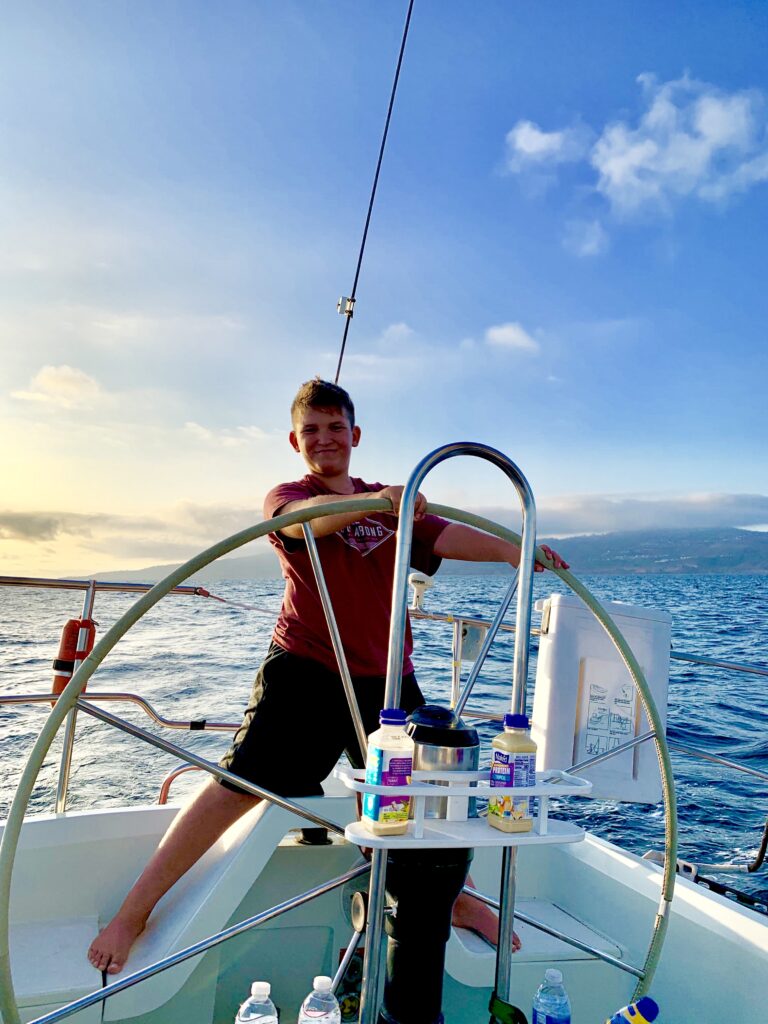I’ve been sharing here and there how we are homeschooling our non-traditional 9th grader this year. I’ve had quite a few questions about what our day looks like so today I’m sharing a typical day in the life of our non-traditional homeschool.
Of my 8 kids, 6 have graduated and one is in school so I am…insert drumroll… homeschooling one kid.
Long past are the days of wild, 3-ring-circus-style homeschooling we had when I had a houseful of kids.
Here are a few of my older posts of what a day in the life of our homeschool looked like with lots of ages and stages.
Day-in-the-Life 2022: High School and Middle School
Day-in-the-Life 2018: High School, Middle School, Elementary School
Day-in-the-Life 2016: Middle School, Elementary School, and Kindergarten
Homeschooling the Non-Traditional Learner in High School
My current 9th grader is probably the most complex of all my kids so far, so figuring out how to best teach him is not exactly easy but it is no doubt the best possible option for him.
The longer I homeschool my kids with dyslexia, dysgraphia, and ADHD, the more I lean toward an unschooling mindset.
Essentially, unschooling is using a child’s interests to direct their learning. There are many ways to incorporate this ideology into your day-to-day learning. Some, more committed unschoolers, use no curriculum unless the child expresses a desire to learn that way.
I (like many homeschoolers) have long been a part-time unschooler. Each morning, we focus on as much reading, writing, and math as we can followed by some read aloud time and then allow everyone to follow their interests for the rest of the afternoon.
You can read all about what unschooling is here and how to get started unschooling here.
If I want my kids to be motivated and engaged, they need to be at lest somewhat interested in what they are learning.
I used to refer to this as Interest-led learning. You can read about how we used our kids’ interests for learning here.
A Day-in-the-Life: High School with Dyslexia and ADHD
So here’s what a typical homeschool day looks like in our home. Since I get questions about how I run this site as well as homeschool, I’ll add some of those details too.
5:00 am: I’m up and prepping for my day. This usually includes coffee, an hour or so of essential quiet time, and planning my work, school, and life plans for the day.
6:00 am: Focused work time for me. This could be writing new blog posts, answering emails, working on long-term projects, or dealing with the myriad technical aspects of running a website.
7:00 am: Get my 7th grader up and get him to school. Yes! My youngest son attends a local micro school for middle schoolers nearby. He wanted to go to school and so that is what he is doing. More on that in another post…
8:00 am: Connect with my 9th grader on what our plan is for today. He’s getting really good at being aware of and expressing his needs each day.
You know how kids with dyslexia and ADHD can have good days of learning and then, for no apparent reason, have days when learning just isn’t happening? It’s a thing. 100%
I mark up his student planner with our joint goals for learning as well as goals for other things like music practice, exercise, and any extra work he’ll do around the house and yard.
9:00 am – 12:00 pm: This is where a timeline is no longer helpful!
With the list as a goal, I allow him a lot of freedom to choose what he does and when.
Oftentimes, he’ll spend a great deal of time outside in the mornings. Honestly, he’s most likely procrastinating (very common with ADHD). Giving him this autonomy is hugely motivating though. Eventually, he comes to me when he is ready to get started.
I’m able to sneak in my own work and household things during these times, so this relaxed, non-schedule works.
Courses and Curriculum for our Non-Traditional Homeschool
Here are the academic things that are usually on his list:
Science: Oceanography: We are using Wondrium (which used to be The Great Courses) video-based course as the main curriculum for science. This is an undergraduate college-level course so I don’t expect him to master everything he learns. Far from it, actually.

We watch the video together. We discuss what we learned, especially things that maybe surprised us or were meaningful for some reason. He has a lot of knowledge of the ocean already since we live near the beach and have sailed extensively his whole life. I’m often impressed by the connections he makes between what he’s learning and what he already knows.
About once a week, we’ll pick a topic for deeper exploration. Using YouTube, he’ll watch a variety of videos and narrate or write about what he learned. So for example, when we learned about wind patterns and weather, he researched the Coriolis Effect and wrote about it.
I chose Oceanography for his Physical Science credit because he will almost certainly go into our family boating business and this info is both an area of interest and relevant to his future career.
Math: Although we are longtime, dedicated Teaching Textbooks fans, we did switch back to Math U See for this kid who always wants to know why he’s doing things. Math U See is unmatched in its use of hands-on materials to teach math concepts. It also works better for him because he does better with a mastery-based approach than with a spiral approach.
Mastery vs Spiral Approach to Teaching Math
The spiral approach has been the traditional method of teaching math for many years. In a spiral curriculum, concepts are reviewed more frequently over time. For example, as a spiral curriculum progresses, daily lessons include review of a wide variety of problems they have learned in previous lessons. The spiral approach is marked by more frequent, usually daily, review.
In a mastery approach, students are required to master one topic before moving on to the next. This mastery approach believes that there is no need for review since the concepts are already ‘mastered’. My son, and probably because of his significant ADHD, found that the kind of review found in a spiral-based curriculum required too much flexible thinking and was exhausting.
History: World History with an emphasis on Medieval History. We started with The Good and The Beautiful which claims to be adaptable for all grades but the materials are way too young for a 15-year old so we are massively improvising.
I chose TGATB because of its approach to teaching history. They cover all of world history each year while focusing on different aspects of each time period. Year 1 happens to focus on Medieval History which is an interest of my son.
I use their Year 1 History as a guide and use other books and videos to supplement. Most of our read-alouds are historical fiction and pair up with this time period.
Read more about modifying curriculum here.
So I read, we discuss, and that’s History.
English:
Literature comes through history read-alouds.
Writing comes in many forms through our other studies. Severe dysgraphia makes the physical act of writing very difficult so when the goal is for him to organize and express his ideas, he’ll do a lot of narrating – speaking his ideas either to me or with a speech-to-text app.
We also focus a little each week on everyday writing. Writing notes, filling out forms, making work and shopping lists, etc.
Grammar: Grammar can be haaaard for people with dyslexia. The rules don’t stick so the best solution I have found is a small amount of daily practice. We have been accomplishing this for the past few years with Daily Grams. Finishing a page a day takes about 10 minutes and there is a lot of review. So far this has worked better (meaning he actually applies what he’s learning to his everyday writing) than any other method or curriculum we have tried.
Spelling: Ahhh, spelling! Although my son can read anything now, spelling is another story. My all-time favorite spelling program is the All About Spelling program which goes along with the All About Reading program. We just work through part of a lesson a day; learning the rules and doing tons of consistent practice.
Reading: Just a note here if you have an older child who is still struggling with reading. I wrote a whole post about that including a review of a program that I highly recommend for older struggling students.
Help for the Older Struggling Reader
High School Electives
The beauty of homeschooling is the freedom to tailor our kids’ education to their unique needs. High school can make this a bit more challenging since we’re dealing with graduation requirements. For this reason, electives are GOLD in high school.
Seamanship: He had the opportunity of a lifetime to travel to Panama (yes, Central America) with his dad to sail a boat back to the United States. Counting the hours that he was learning is the equivalent of a year-long high school course.
Cooking: He chooses, plans, and cooks one family meal per week.
PE: He is taking a martial arts-based self-defense class 3 days a week that counts for a mandatory PE credit.
How much we do each day varies widely. Some days we do lots of academic work and some days we read most of the day and get out of the house for a hike. At the end of the year, this gentle, non-traditional approach will have covered all I need to cover and much more.
Why a Non-Traditional Approach Works so Well
I talk to so many parents whose teens are resistant to learning. They lack motivation which often makes homeschool days miserable and puts a ton of strain on the parent-child relationship.
Tapping into interests is key. For us, choosing to focus on areas of history and science that are relevant to his life fosters both interest and confidence.
Generous use of accommodations and modifications. I read a quote recently that said, “Students don’t hate math. They hate being confused, intimidated, and embarrassed by math.” If our kids can be taught at their level of competency (the learning is neither too hard nor too easy) their confidence takes off.
How do you modify and accommodate your non-traditional learners? Leave a comment below!






It is so cool that he is learning oceanography and seamanship as well as the more standard school subjects. What a fantastic life skill to include, that he can actually definitely use, rather than only the syllabus legal requirements. I wish that were an option for our autistic son.
Thanks Duncan. I know we are so fortunate to be able to offer this to him!
As a homeschooling mom who has heard you speak several times and followed you for years, I too am finding the lean towards unschooling to be life-giving for both student and parents while also keeping my curriculums close by.
Question–how do you handle grades for your high schoolers within the “unschooling” atmosphere?
Hi Jen. I need to do a post about this. There are 2 ways: finish 75% of the curriculum or count hours 120-180 hours make a year course. You also have 100% control over what you cover and what you count for grades. You do not have to use a traditional method for educating your kids. You are the head of the school. 🙂
Marianne, I’m on my youngest child out of 8 and I’m finding it exhausting some days because it’s just him and me so he looks to me to do things with all day. How are you navigating that aspect of homeschooling one?
Thank you